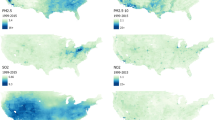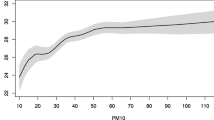Abstract
Assessing the long-term benefits of marginal improvements in air quality from regulatory intervention is methodologically challenging. In this study, we explore how the relative risks (RRs) of mortality from air pollution exposure change over time and whether patterns in the RRs can be attributed to air quality improvements. We employed two-stage multilevel Cox models to describe the association between air pollution and mortality for 51 cities with data from the American Cancer Society (ACS) cohort (N = 264,299, deaths = 69,819). New pollution data were computed through models that predict yearly average fine particle (PM2.5) concentrations throughout the follow-up (1982–2000). Average PM2.5 concentrations from 1999 to 2000 and sulfate concentrations from 1980 were also examined. We estimated the RRs of mortality associated with air pollution separately for five time periods (1982–1986, 1987–1990, 1991–1994, 1995–1998, and 1999–2000). Mobility models were implemented with a sub-sample of 100,557 subjects to assist with interpreting the RR estimates. Sulfate RRs exhibit a large decline from the 1980s to the 1990s. In contrast, PM2.5 RRs follow the opposite pattern, with larger RRs later in the 1990s. The reduction in sulfate RR may have resulted from air quality improvements that occurred through the 1980s and 1990s in response to the acid rain control program. PM2.5 concentrations also declined in many places, but toxic mobile sources are now the largest contributors to PM in urban areas. This may account for the heightened RR of mortality associated with PM2.5 in the 1990s. The paper concludes with a three alternative explanations for the temporal pattern of RRs, each emphasizing the uncertainty in ascribing health benefits to air quality improvements.






Similar content being viewed by others
Abbreviations
- NRC:
-
National Research Council
- ACS:
-
American Cancer Society
- TSP:
-
Total suspended particulate
- PM10 :
-
Particles less than or equal to 10 μm in diameter
- PM2.5 :
-
Particles less than or equal to 2.5 μm in diameter
- RR:
-
Relative risk
- CR:
-
Concentration-response
- MSAs:
-
Metropolitan statistical areas
- CVD:
-
Cardiovascular disease
- GAM:
-
Generalized additive model
- SO4 :
-
Sulfate
- EPA:
-
Environmental Protection Agency
References
Cakmak S, Burnett RT, et al (2003a) Spatial regression models for large-cohort studies linking community air pollution and health. J Toxicol Environ Health A 66(16–19):1811–1823
Clancy L, Goodman P, et al (2002) Effect of air-pollution control on death rates in Dublin, Ireland: an intervention study. Lancet 360(9341):1210–1214
EPA (2005) Trends in sulfur dioxide emissions following implementation of Phase I of the acid rain program: total state-level utility SO2 (1980, 1990, 1999). Environmental Protection Agency, Washington DC, USA
Frye C, Hoelscher B, et al (2003) Association of lung function with declining ambient air pollution. Environ Health Perspect 111(3):383–387
Getis A, Getis J (1995) The United States and Canada: the land and the people. Wm. C. Brown Publishers, Dubuque, IA
Hedley AJ, Wong CM, et al (2002) Cardiorespiratory and all-cause mortality after restrictions on sulphur content of fuel in Hong Kong: an intervention study. Lancet 360(9346):1646–1652
HEI (2003) Assessing health impact of air quality regulations: concepts and methods for accountability research. HEI Communication 11, Health Effects Institute, Boston
Heinrich J, Hoelscher B, et al (2002) Improved air quality in reunified Germany and decreases in respiratory symptoms. Epidemiology 13(4):394–401
Heinrich J, Hoelscher B, et al (2000) Decline of ambient air pollution and respiratory symptoms in children. Am J Respir Crit Care Med 161(6):1930–1936
Jaakkola JJ, Partti-Pellinen K, et al (1999) The South Karelia air pollution study: changes in respiratory health in relation to emission reduction of malodorous sulfur compounds from pulp mills. Arch Environ Health 54(4):254–263
Jerrett M, Burnett RT, et al (2003) Spatial analysis of the air pollution-mortality relationship in the context of ecologic confounders. J Toxicol Environ Health A 66(16–19):1735–1777
Jerrett M, Finkelstein M (2005) The geography of risk in cohort studies linking air pollution exposure to mortality. J Toxicol Environ Health 68:1207–1242
Koushik A, King WD, et al (2001) An ecologic study of childhood leukemia and population mixing in Ontario, Canada. Cancer Causes Control 12(6):483–490
Krewski D, Burnett RT, et al (2000) Reanalysis of the Harvard six cities study and the American Cancer Society study of particulate air pollution and mortality. Health Effects Institute, Cambridge, MA
Laden F, Schwartz J, et al (2006) Reduction in fine particulate air pollution and mortality: extended follow-up of the Harvard six cities study. Am J Respir Crit Care Med 117(6):667–72
Lall R, Kendall M, et al (2004) Estimation of historical annual PM2.5 exposures for health effects assessment. Atmos Environ 38:3107–3125
Long L (1988) Migration and residential mobility in the United States. Russell Sage Foundation, New York
Nel A (2005) Atmosphere air pollution-related illness: effects of particles. Science 308(5723):804–806
Newbold KB (2001) Counting migrants and migrations: comparing lifetime and fixed-interval return and onward migration. Econ Geogr 77(1):23–40
NRC (2002) Estimating the public health benefits of proposed air pollution regulations. National Academies Press, Washington
Park SS, Kim YJ (2005) Source contributions to fine particulate matter in an urban atmosphere. Chemosphere 59(2):217–26
Pope CA III, Burnett RT, et al (2002) Lung cancer, cardiopulmonary mortality, and long-term exposure to fine particulate air pollution. JAMA 287(9):1132–1141
Stiller CA Boyle PJ (1996) Effect of population mixing and socioeconomic status in England and Wales, 1979–85, on lymphoblastic leukaemia in children. BMJ 313(7068):1297–300
Acknowledgments
We are grateful to the Health Effects Institute, the National Institute of Environmental Health Science (Grants 5 R01 ES 09560, 5P30 ES07048, 5PO1ES011627), and the Verna Richter Chair in Cancer Research for financial support. D. Krewski is the NSERC/SSHRC/McLaughlin Chair in Population Health Risk Assessment at the University of Ottawa. We thank Yuanli Shi, Dan Crouse, Bernie Beckerman, Karen King, and Richard Hamilton for assistance with the statistical analyses, cartography, and graphic design.
Author information
Authors and Affiliations
Corresponding author
Rights and permissions
About this article
Cite this article
Jerrett, M., Newbold, K.B., Burnett, R.T. et al. Geographies of uncertainty in the health benefits of air quality improvements. Stoch Environ Res Risk Assess 21, 511–522 (2007). https://doi.org/10.1007/s00477-007-0133-2
Published:
Issue Date:
DOI: https://doi.org/10.1007/s00477-007-0133-2




